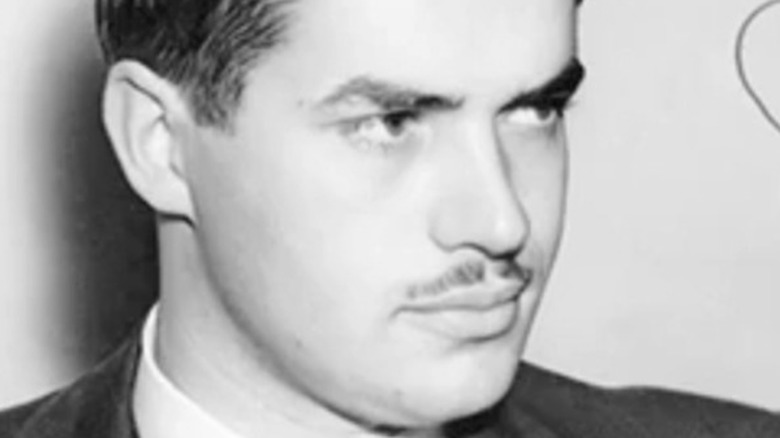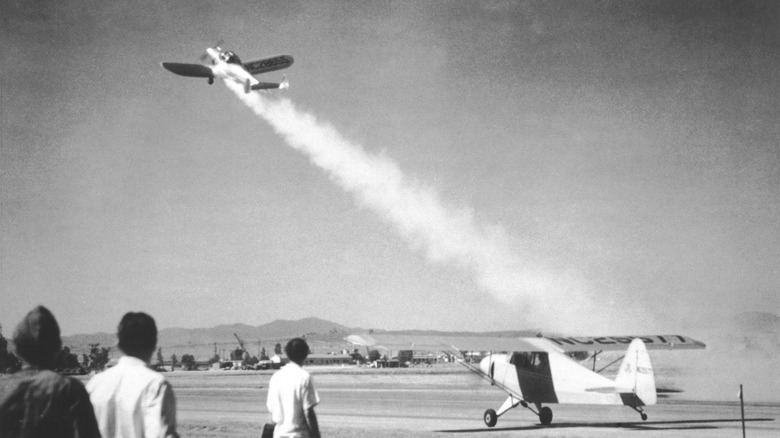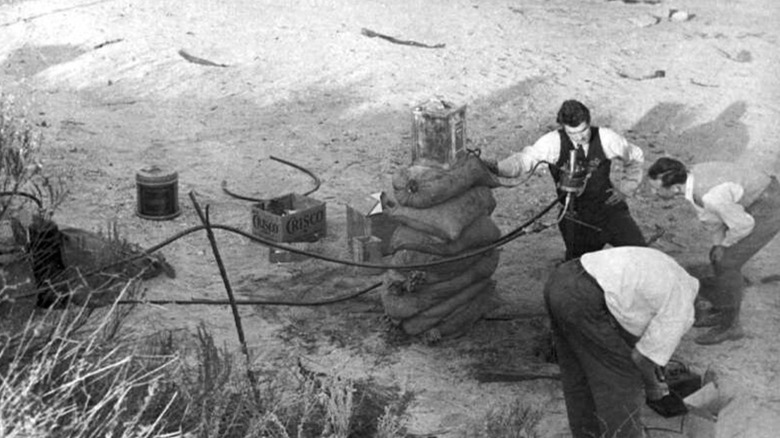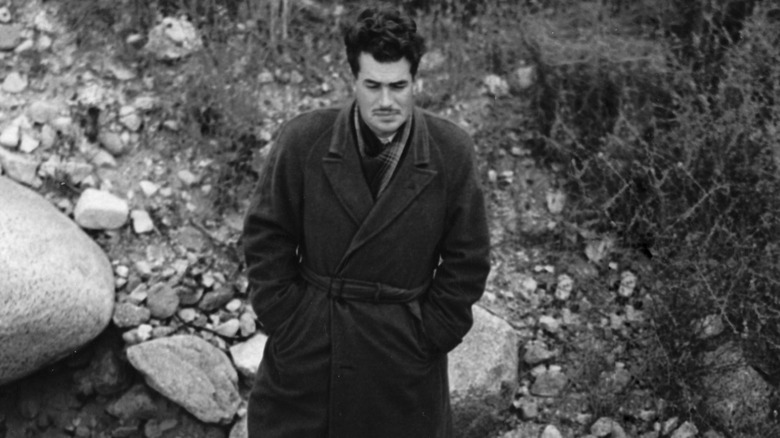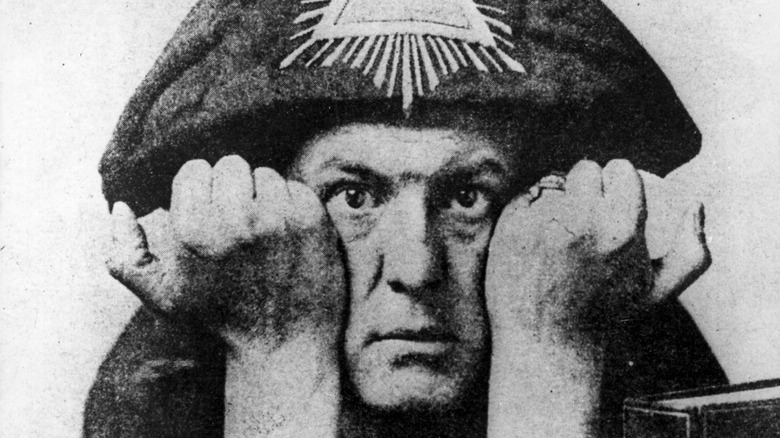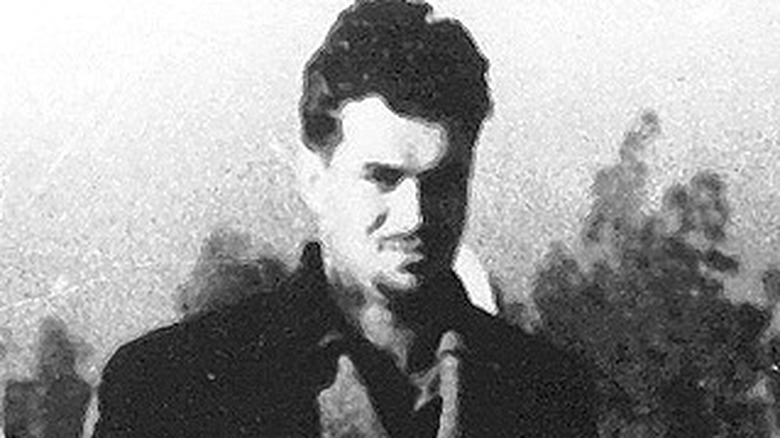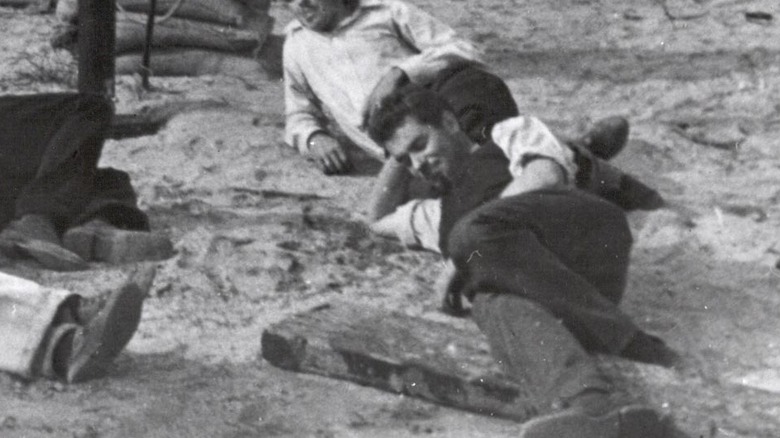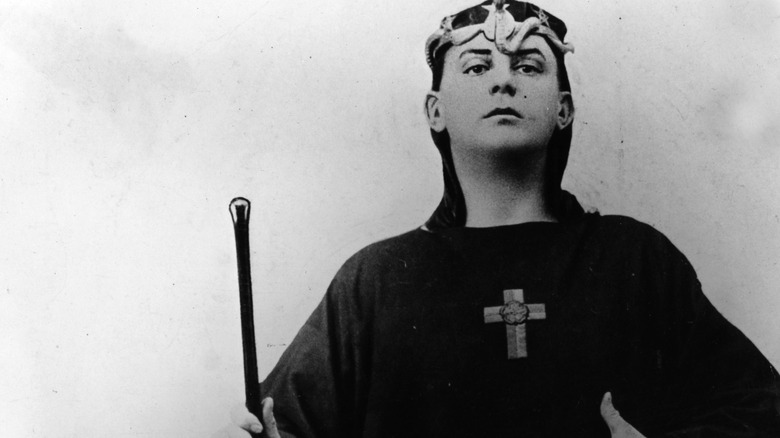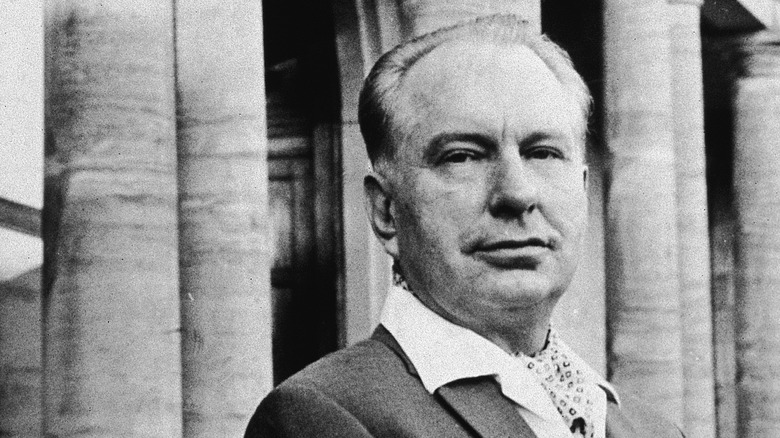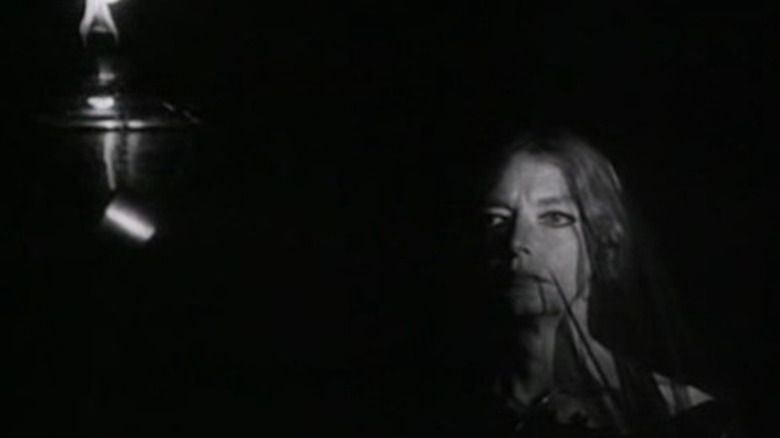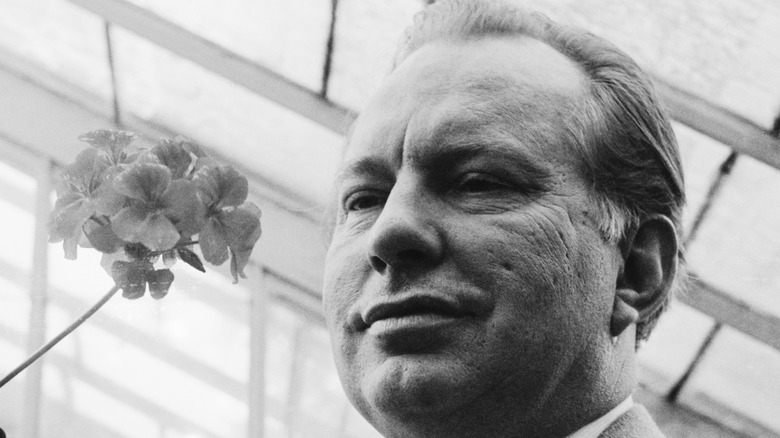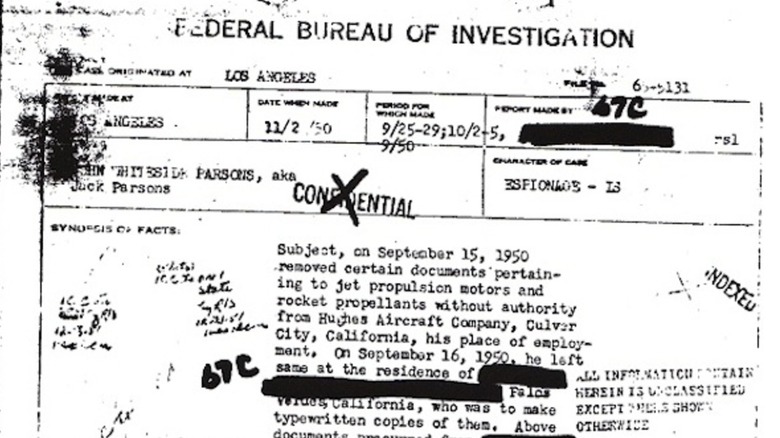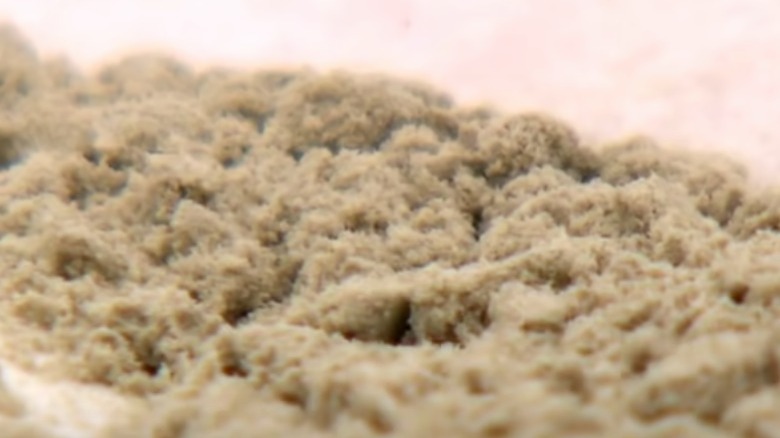The Untold Truth Of Jack Parsons
Jack Parsons has been called the father of rocketry. Born in 1914, the term "rocket scientist" did not even exist. His childhood experimentation with explosives led him to co-found what would become the Jet Propulsion Laboratory before he was 25 years old. JPL went on to build the space crafts that launched the United States into the Space Age.
His professional contributions were revolutionary, but it was his private life that made him one of the most controversial figures in science. As described in the biography by George Pendle, "Strange Angel: The Otherworldly Life of John Whiteside Parsons," Parsons was attractive and sophisticated with a good sense of humor. Per Vice, he was notorious amongst his friends and colleagues for carrying a pet cobra on his shoulders during meetings and seducing the secretaries to go home with him and perform arcane rituals.
This was not unusual for Parsons, who was deeply fascinated by the occult. He believed that he was able to work magic and frequently used fire, blood, and sex to attempt to summon ancient deities.
His real name was Marvel
The man who eventually came to be known as Jack Parsons was actually named Marvel Whiteside Parsons. Although he was called Jack for the majority of his life, his name was never legally changed from Marvel. Parsons was named after his father, Marvel. As described in the history podcast "The Dollop," his parents soon split up. Parsons lived with his mother in a wealthy part of Pasadena known as "Millionaires' Mile." His father no longer had any contact with the family, and his mother decided she no longer wanted to call her son by her ex-husband's first name. Without ever formally changing his name, she began referring to him as John.
When he was young, Parsons attempted a magical ritual to summon the devil into his childhood bedroom but became terrified that he had accidentally succeeded and gave up the occult until adulthood. By his own admission, he was an isolated child and often struggled with bullying. He came to detest others and their morality — particularly Christianity. When Jack was around 13, he made a friend named Ed Foreman, and they bonded over a mutual love of rockets. Soon, the yard of the Parsons' family home was pitted and charred from the two boys setting off explosives. Parsons was sent to a military school but was swiftly expelled for causing an explosion in the bathroom.
He and his friends were known as the Suicide Squad
After high school, Jack Parsons attempted to get a college degree, but his family's fortune had taken a considerable hit, and he was unable to afford it. As stated by the New York Post, Parsons was never able to get a college education. Despite this, Ed Foreman and Parsons continued their experiments with rockets.
Looking for expert advice, the two turned to Frank Malina, a grad student at Caltech with an interest in rocket propulsion and space flight. The three convinced Theodore von Karman, a respected scientist and engineer, to let them use the lab for their experiments with rockets. As described by Smithsonian, the three were soon working on a high altitude-sounding rocket as part of Malina's thesis. Students and faculty alike worried that their work was too dangerous for campus. They even earned the nickname "suicide squad" because of how dangerous the experiments were thought to be.
He was a pioneer
As a child, Jack Parsons was interested in science fiction (which is likely where his initial interest in rockets came from), and he was fascinated by the idea of humans traveling through space and to the moon (via the New York Post). He ultimately helped found what became NASA's Jet Propulsion Laboratory, which created the spacecraft that brought the United States into the space age, the camera that first photographed the Earth from space, and continues to design spacecraft and rovers. Parsons developed a solid rocket fuel that could be stored indefinitely, which was ultimately used by NASA for the Space Shuttle.
Due to fears about fires and explosives, Parsons and his collaborators moved away from the Caltech campus and to a canyon in western Pasadena (near where NASA's Jet Propulsion Laboratory would one day be). As described in Smithsonian, they set up multiple experiments there to study rocket propulsion and became pioneers in the field. According to NASA, they received funding from the U.S. military to develop missiles and rockets as World War II approached.
As described by Wired, Jack Parsons is one of the most influential figures in rocketry. However, he is rarely discussed in the history of space travel. This is likely because in addition to rockets, he was obsessed with the occult.
He considered Aleister Crowley a father
Occultist Aleister Crowley was dubbed "the wickedest man in the world" by the press (via Britannica). He was the founder of a religion called Thelema and wrote about mystical experiences and teachings. Per Britannica, the most famous of these teachings was, "Do what thou wilt shall be the whole of law." In his own lifetime, Crowley was a controversial, fringe figure, but he was a close friend and mentor to Jack Parsons, who frequently addressed Crowley as "father."
Parsons' childhood interest in the supernatural only grew as he got older. He had already done things that were impossible in one field, and he believed that magic was the next thing he would conquer. He is quoted as saying (per Vice), "I had the genius to found the jet propulsion field in the U.S., and found a multimillion-dollar corporation and a world-renowned research laboratory ... I should also be able to apply this genius in the magical field."
Parsons attended rituals held by practitioners of Thelema. As stated by Vice, the group's leader would emerge from a coffin to perform rituals at an altar onstage. These frequently involved sex. Crowley believed in a kind of magic that could be accessed with sex. This was particularly controversial at the time because some of his rituals required two men to participate at a time when homosexuality was considered a crime.
Parsons was fascinated, and soon he was exchanging letters with the now-elderly Crowley.
He founded The Parsonage
Jack Parsons' rocket business was doing extraordinarily well, and he decided to use his newfound fortune to further his interest in magic. He returned to Millionaire's Row in Pasadena, buying a massive mansion — but he wasn't planning to live there alone. As stated by Vice, the mansion, which was soon nicknamed The Parsonage, became a boarding house for all types of individuals that shared Parsons' interests. This included fellow scientists as well as artists, writers, and people who claimed they could do magic. Frank Malina's wife Liljan is quoted describing the residents, stating (per Vice), "Some of them had masks on, some had costumes on ...women were walking around in diaphanous togas and weird make-up, some dressed up like animals, like a costume party."
Parsons and his guests performed elaborate rituals. As described in "Strange Angel," couples could often be seen "fire dancing" or leaping over open flames in the backyard to enhance their fertility. The house became infamous and frequently made headlines describing taboo sex acts as a part of arcane rituals.
He was always a divisive figure
While Jack Parsons' contributions to the field of rocketry were revolutionary, his increasingly open interest in the occult and taboo began to make his fellow scientists wary of working with him. As stated in Vice, Parsons didn't always keep his work life and his private life separate. He and his longtime colleague Ed Foreman frequently dueled on their rocket test site, shooting bullets closer and closer to each other like a game of chicken. He would meet colleagues at The Parsonage, often while holding a massive snake. He was also prone to inviting secretaries from the business back to The Parsonage to partake in magical sex rituals and try hallucinogenics. As explained by Wired, the rumors around The Parsonage, both true and untrue, made the U.S. government (which was funding their rocketry research) uneasy. People began to see Parsons as more of a liability than an asset. By the time he was 30 years old, he was being pushed out of the field that he had pioneered.
Parsons continues to be a controversial figure in the history of rocketry and space travel. Many, including Parsons's biographer George Pendle, believe that even today, Parsons isn't credited for his scientific advancements because of the bizarre nature of his personal life.
He embraced the taboo
The rituals that both Aleister Crowley and Jack Parsons believed in were sex magic. As noted in the Los Angeles Times, followers were expected to switch partners regularly. The group held orgies on The Parsonage's lawn, and followers of Crowley's Thelema were expected to let go of jealousy, conduct sexual rituals, and have relationships with anyone they chose. This was one of the major draws to the group, but it was not as popular with Parson's wife Helen when he began a relationship with her 18-year-old half-sister, Sara. Soon, Helen got pregnant by another member of the group, and his relationship with Sara flourished.
The group was also known to take all types of drugs to work their magic — particularly hallucinogens. As stated in "Strange Angel," Crowley told his followers that taking drugs while performing their rituals would allow for "astral travels" and enable them to talk to mystical beings. While Parsons certainly embraced the lifestyle, he struggled to completely let go of jealousy. His commitment would be tested when he met a famous pulp science fiction writer who wanted to take advantage of the sexual freedom The Parsonage provided: L. Ron Hubbard.
He was friends with the founder of Scientology
This reputation brought many like-minded individuals into Jack Parsons' life. Possibly the most bizarre of these was a famous science fiction writer named L. Ron Hubbard — the man who would go on to found the alleged cult known as Scientology. According to Parsons' biographer George Pendle, the idea for Scientology's structure can be traced back to his time following Parsons at The Parsonage.
Many who met Hubbard found him untrustworthy, but Parsons instantly took a liking to him. As quoted in "Strange Angel," when Parsons met Hubbard, he immediately wanted to be friends and wrote to his mentor Aleister Crowley: "Although [Hubbard] has no formal training in Magick, he has an extraordinary amount of experience and understanding in the field." The two frequently talked about science fiction, practiced fencing, and performed magic rituals together. The most notable of these were known as Babalon Working. As detailed in "Magia Sexualis: Sex, Magic, and Liberation in Modern Western Esotericism," Parsons and Hubbard were attempting to open a magic doorway to another realm, allowing the goddess Babalon to enter their world in the form of a human woman. These rituals often centered around masturbation.
He believed he created a woman
While his father figure Aleister Crowley thought that Babalon Working was idiotic, Jack Parsons believed that he and L. Ron Hubbard were successful in summoning the goddess. Shortly after one of the rituals designed to produce the ideal woman, Parsons met Marjorie Cameron.
As described by HuffPost, Cameron was a young, gothic-looking woman with bright red hair who often drove a hearse. Cameron, as noted by Wired, had no idea that her lover believed that he had conjured her. While Parsons seems to have continued to be interested in Sara, Cameron became his muse, inspiring him to write an entire book of poetry. He called Cameron the "Scarlet Woman," believing she was the goddess invoked into human form and his destined lover. They eventually married.
Cameron became a force in Los Angeles' occult community in her own right. She created numerous artworks inspired by her "visions" gained through rituals and psychedelics. In his writings, Parsons described visions of a woman and a goat dancing — and the truly terrifying figure is the woman. As described by biographer George Pendle in an interview with Wired, "This is how he saw his relationship with Cameron. She was a girl he'd summoned, but he was also terrified of her."
Parsons was grifted by L. Ron Hubbard
Aleister Crowley, still living in England and hearing about what was happening at The Parsonage from his followers, began to suspect L. Ron Hubbard was a con man. Ultimately, he was proved right.
Hubbard was particularly interested in the sexual aspect of life at The Parsonage. While Jack Parsons trusted his ritual partner completely, Hubbard ended up seducing Parsons' girlfriend Sara (per Vice). As explained in "Strange Angel," Hubbard convinced Parsons to stop working with his childhood friend and partner Ed Foreman and instead invest almost all of his money into a business with him and Sara. Hubbard proposed that he and Sara would go to Miami and buy several yachts and then sell them in California at a significant markup. Trusting Hubbard completely and hoping to win Sara back, Parsons agreed. By the time Parsons became suspicious, Hubbard and Sara had run away together, taking all of Parsons' money with them.
Parsons attempted to summon a vengeful spirit to stop Hubbard and Sara, and when their ship was rendered unusable by a storm, he believed he had succeeded (though it was more likely the result of Hubbard's lack of sailing ability —he had been lying about his time in the U.S. Navy). Parsons was only ever to get a small percentage of his money back from Hubbard, and Sara threatened to press charges against him if he tried for more — she had been underage when their relationship began. Parsons was emotionally devastated by Hubbard's betrayal and never fully recovered.
He was investigated by the FBI
As far back as when Jack Parsons and his collaborator had relocated from the Caltech labs (which they had damaged) to the canyon, the FBI had been watching them. As stated by Wired, there were concerns that political extremists might try to use the explosives. Years later, they revoked Parsons's security clearance because they feared he himself was a political extremist (via the New York Post).
As rockets and jet propulsion went from an eccentric hobby to something financed by the U.S. military, Jack Parsons' personal life became a matter of national importance. As stated in "Strange Angel," he was investigated by both local and national authorities many times. The FBI began collecting data on Parsons, and they referred to his "religious cult, believed to advocate sexual perversion" at The Parsonage. During the anti-communist fervor of the Red-Scare, the FBI temporarily revoked Parsons's security clearance because they believed he had communist connections. He was also accused of espionage, and though he was found not guilty and regained his security clearance, he never worked in science again.
Unable to find work in his field and having lost his fortune to Hubbard, Parsons found himself having to work odd jobs. As noted by Vice, he pumped gas and repaired cars until he secured work in Hollywood, doing pyrotechnics for films.
He died in an explosion
In 1952, a massive explosion blew apart the home laboratory in Jack Parsons' garage. He had continued to experiment with illegal explosives and, according to police reports (detailed in the Los Angeles Times), Parsons dropped fulminate of mercury, causing an enormous and deadly blast that could be felt more than a mile away. He was 37 years old. As described in "Strange Angel," the police who arrived at the scene believed that Parsons had been using an old coffee can to mix the chemicals, accidentally dropped it, and lunged to catch it before the highly combustible fulminate of mercury hit the ground. He missed, and when the can struck the ground, the explosion went off in Parsons' face.
The tabloids went wild, not only describing Parsons' death but also his work in science and black magic. Authorities had determined that his death was an accident (or possibly suicide, as noted by the Los Angeles Times), but soon, there were numerous conspiracy theories about the explosion. The most popular of these was that he had been murdered. In 1938, Parsons had testified against an LAPD detective named Earl Kynette. Parsons was called as an expert in explosives, and Kynette was convicted of planting a car bomb. Kynette was paroled shortly before the explosion that killed Parsons, leading some — including Parsons's wife Marjorie Cameron — to believe he had been murdered.
